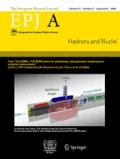Abstract:
Coherent states are used as trial states to determine, variationally, the structure of the eigenvectors belonging to a schematic Hamiltonian consisting of single-particle, pairing and residual proton-neutron interaction terms. It is shown that the standard proton-neutron quasiparticle random-phase approximation (pn-QRPA) is recovered, as a variational theory, by replacing quasiparticle pair creation and annihilation operators by bosons. It is also shown that an exact, algebra preserving, mapping of the Hamiltonian is needed to describe the spectrum beyond the QRPA phase transition. The role of the spurious components of the trial wave functions is discussed.
Similar content being viewed by others
Author information
Authors and Affiliations
Additional information
Received: 19 February 2002 / Accepted: 3 May 2002
Rights and permissions
About this article
Cite this article
Hirsch, J., Hess, P. & Civitarese, O. The use of coherent states in the variational treatment of proton-neutron interactions. Eur Phys J A 14, 355–364 (2002). https://doi.org/10.1140/epja/i2002-10029-5
Issue Date:
DOI: https://doi.org/10.1140/epja/i2002-10029-5


